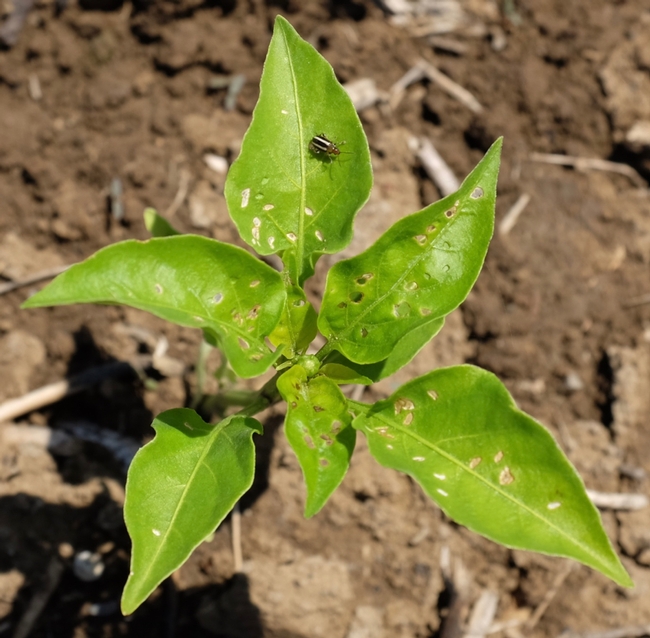Flea beetles have been abundant this spring and have been a surprise to many because larger genera of flea beetles and resulting larger holes have been present. The stable, warm spring with few heat waves has been favorable to their development. The characteristic large hind femurs allow the insect to spring up for movement, but they can also fly. One species recently noted in the valley is the palestriped flea beetle (Systena blanda) which are larger than most flea beetles, about 0.12 inches long, and are dark brown with a white stripe on each wing.
Photo: Palestriped flea beetle on a pepper plant in Yolo County (May 21, 2018)
Flea beetles enjoy a wide host range of crops including peppers, carrots, beans, beets, eggplants, lettuce, melons, peas, pumpkins, tomatoes, potatoes, alfalfa, radishes and most cole crops. These beetles feed on the underside of leaves, usually leaving pits or holes in the leaves. However, in the photo, you can see larger hole damage that one may not expect from a flea beetle. Flea beetles lay eggs in the soil around the plant, on the leaves, or in cavities of hollowed out stems. Larvae living in the soil can feed on roots causing stunting. While this is generally not a problem, it can cause serious damage on occasion.
MANAGEMENT
Mature vegetable crops can tolerate high numbers of flea beetles. They do the most economic damage when seedlings are just emerging or transplants are not yet well established. Once plants have five true leaves, they are usually not highly impacted by flea beetle damage. However, stress from leaf damage can be exacerbated under very hot, dry, or windy conditions.
When plants are in the cotyledon and first leaf stage, monitoring for this pest should be done every two weeks. Thresholds for treatment vary depending on the plant, but as a general rule, beetles should be treated when scouting shows the following levels of infestation:
|
Height of plant |
Number of beetles per plant |
|
< 3” |
2 beetles |
|
3-6” |
4 beetles |
|
> 6” |
8 beetles |
Protective coverings, such as floating row cover, can be used to exclude insects from a new or emerging planting. If flea beetles have been a problem in the past and/or have been identified in the surrounding weed margin, protective coverings can be very effective to establish a crop. However, it must be provided before the crop emerges or immediately after transplanting to be most effective.
Larvae overwinter in the soil and on crop residue. Burying crop residue as well as disking weeds in the field margins are usually effective control mechanisms. Cereal grains are non-hosts and will reduce population buildup in the fall and spring.
Sufficient irrigation and fertilization are also key to improving recovery from flea beetle damage.
If an outbreak is particularly bad, one application of an approved insecticide is usually sufficient to control the population. This can be applied as a spot treatment or on the field margins, if populations are identified there. Baits are not effective.
If flea beetles are an on-going challenge, trap cropping with the highly desirable crop Chinese Southern Giant Mustard (Brassica juncea var. crispifolia) can be effective. One row every 55 yards between or bordering the main crop can be protective. More on trap cropping is described in the ATTRA guide.
For more information about the pale-striped flea beetle and control mechanisms, see:
Carrot Palestriped Flea Beetle
Alfalfa Pale-striped Flea Beetle
ATTRA Flea Beetle Guidelines (attached)
Attached Files:
